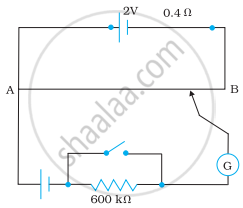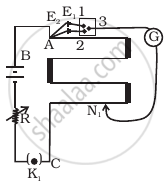Advertisements
Advertisements
प्रश्न
Write the principle of working of a potentiometer. Describe briefly, with the help of a circuit diagram, how a potentiometer is used to determine the internal resistance of a given cell.
उत्तर
The working principle of a potentiometer is based on Kirchhoff’s voltage law. According to this rule, the algebraic sum of changes in voltage around any closed loop involving resistors and cells in the loop is zero.

Let Φ be the potential drop per unit length in the potentiometer wire.
When only a cell is connected, the balance point is N1.
Appling Kirchhoff’s voltage law,
ε = Φ l1 [l1 = Length at which the balance point is achieved]
When some current is drawn using the resistance box, the balance point is achieved at N2.
V = Φl2
This gives,
`epsi/V = l_1 / l_2`
ε = I (r + R) [R = Resistance of the resistance box]
V = IR
This gives,
`epsi /V = (r+R)/R`
`r = R (l_1/l_2 - 1)`
The internal resistance of the cell can be determined by plugging-in the measured values of l1 and l2.
APPEARS IN
संबंधित प्रश्न
Figure shows a potentiometer with a cell of 2.0 V and internal resistance 0.40 Ω maintaining a potential drop across the resistor wire AB. A standard cell which maintains a constant emf of 1.02 V (for very moderate currents up to a few mA) gives a balance point at 67.3 cm length of the wire. To ensure very low currents drawn from the standard cell, very high resistance of 600 kΩ is put in series with it, which is shorted close to the balance point. The standard cell is then replaced by a cell of unknown emf ε and the balance point found similarly, turns out to be at 82.3 cm length of the wire.

(a) What is the value ε?
(b) What purpose does the high resistance of 600 kΩ have?
(c) Is the balance point affected by this high resistance?
(d) Is the balance point affected by the internal resistance of the driver cell?
(e) Would the method work in the above situation if the driver cell of the potentiometer had an emf of 1.0 V instead of 2.0 V?
(f) Would the circuit work well for determining an extremely small emf, say of the order of a few mV (such as the typical emf of a thermo-couple)? If not, how will you modify the circuit?
State any one use of a potentiometer.
Sensitivity of a given potentiometer can be decreased by ______.
In the experiment of potentiometer, at balance point, there is no current in the ______.
The instrument among the following which measures the e.m.f of a cell most accurately is ______
In a potentiometer circuit a cell of EMF 1.5 V gives balance point at 36 cm length of wire. If another cell of EMF 2.5 V replaces the first cell, then at what length of the wire, the balance point occurs?
In an experiment with a potentiometer, VB = 10V. R is adjusted to be 50Ω (Figure). A student wanting to measure voltage E1 of a battery (approx. 8V) finds no null point possible. He then diminishes R to 10Ω and is able to locate the null point on the last (4th) segment of the potentiometer. Find the resistance of the potentiometer wire and potential drop per unit length across the wire in the second case.

In a potentiometer arrangement, a cell of emf 1.20 V gives a balance point at 36 cm length of wire. This cell is now replaced by another cell of emf 1.80 V. The difference in balancing length of potentiometer wire in above conditions will be ______ cm.
State dimension of potential gradient.
